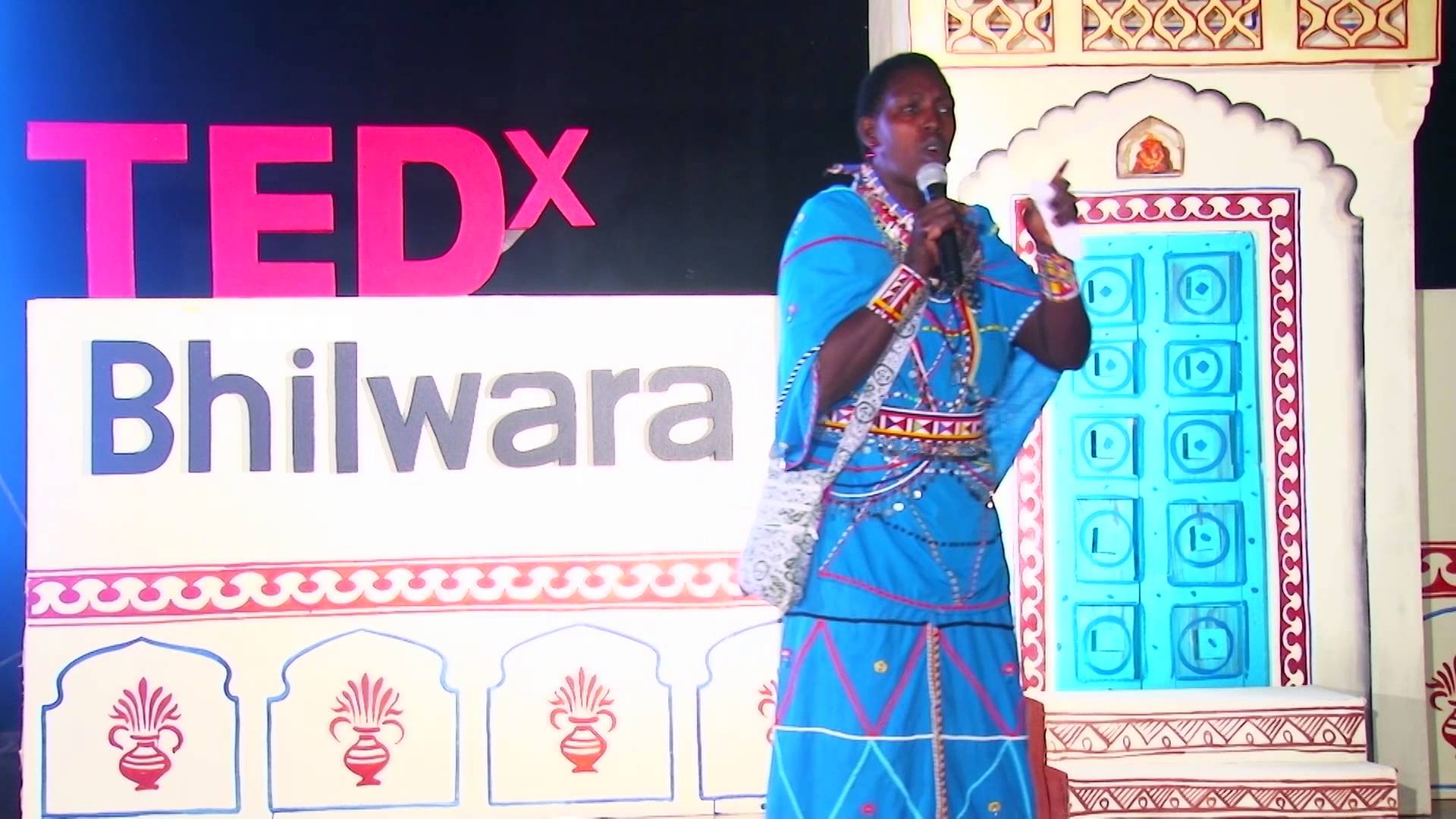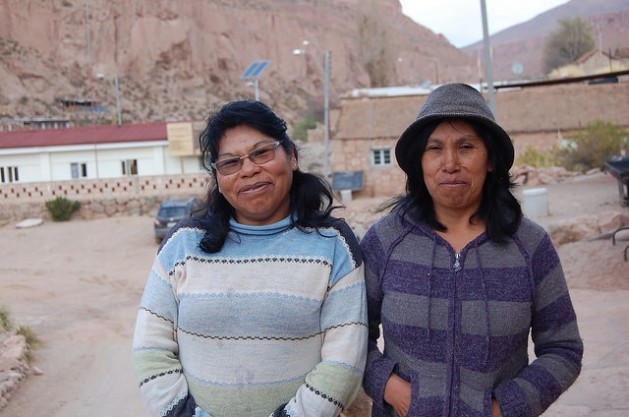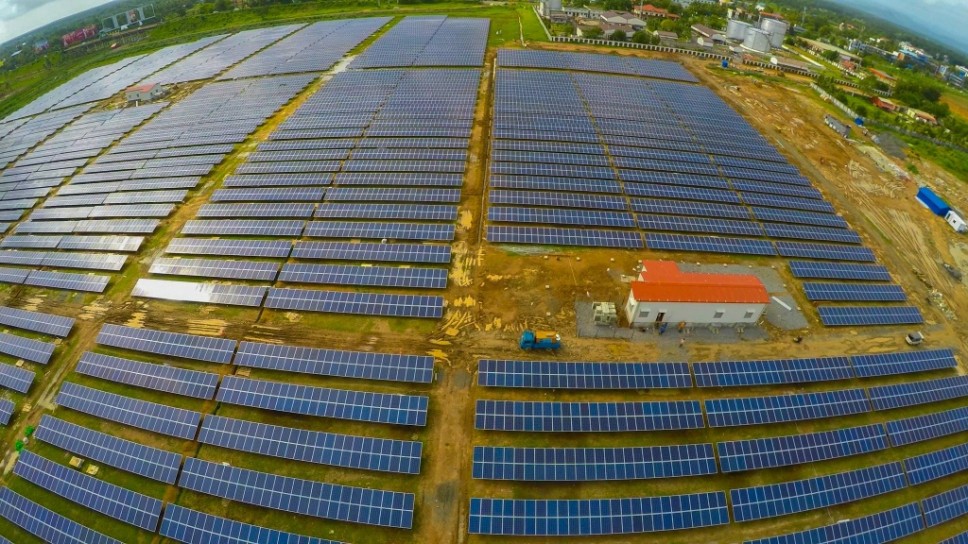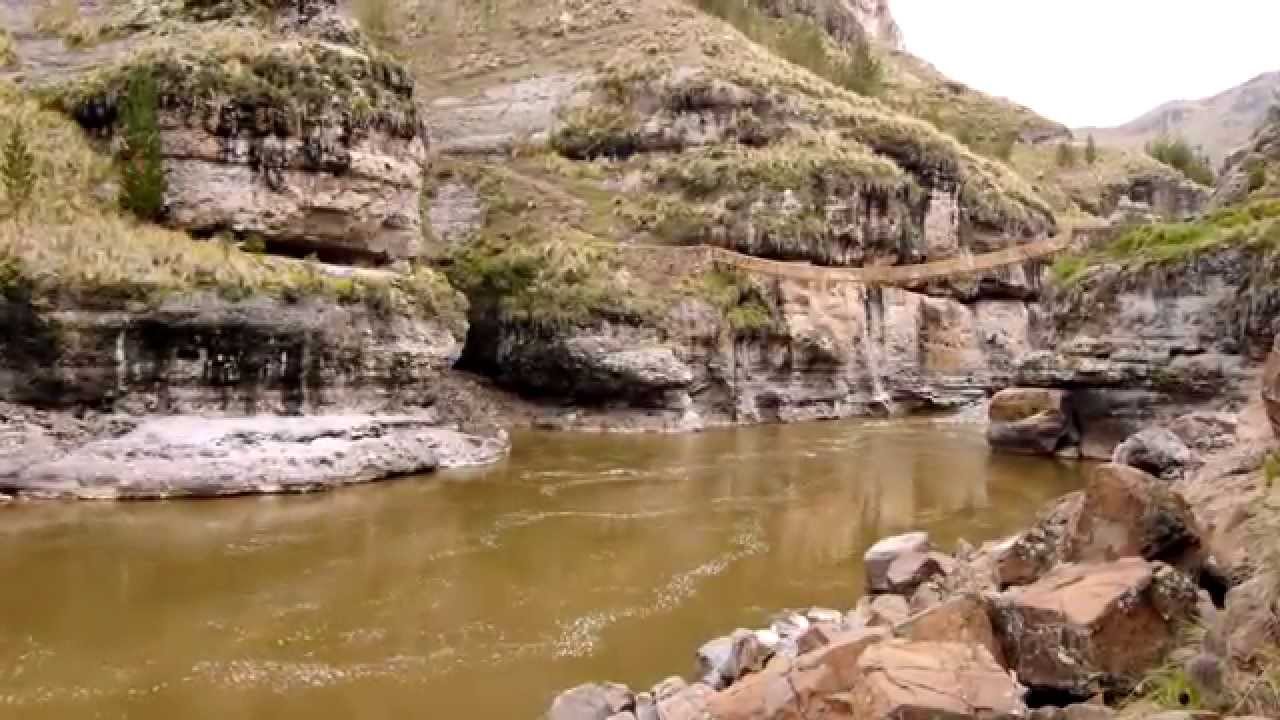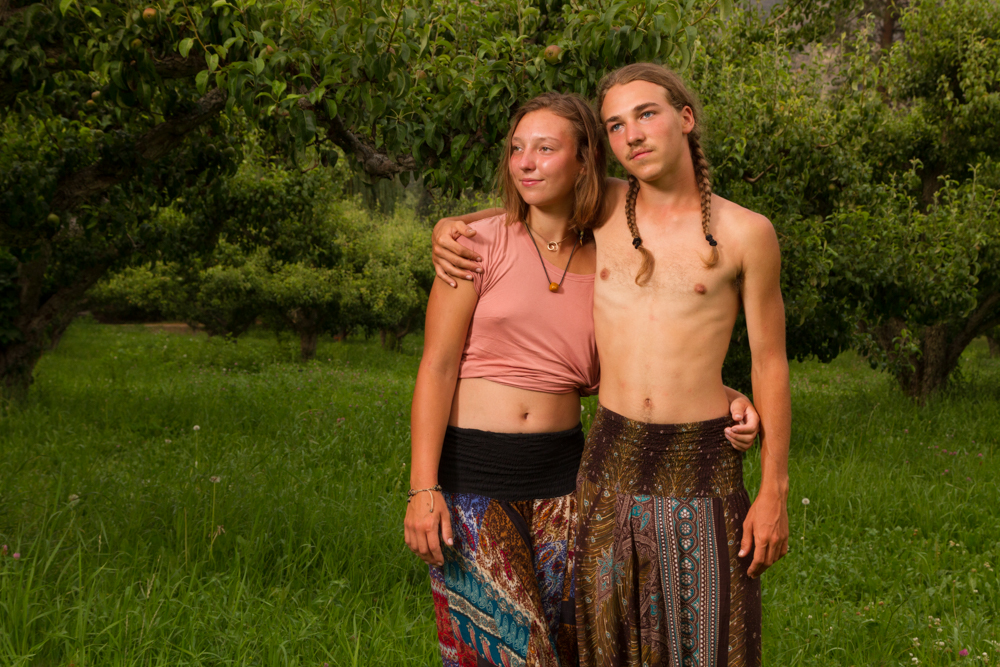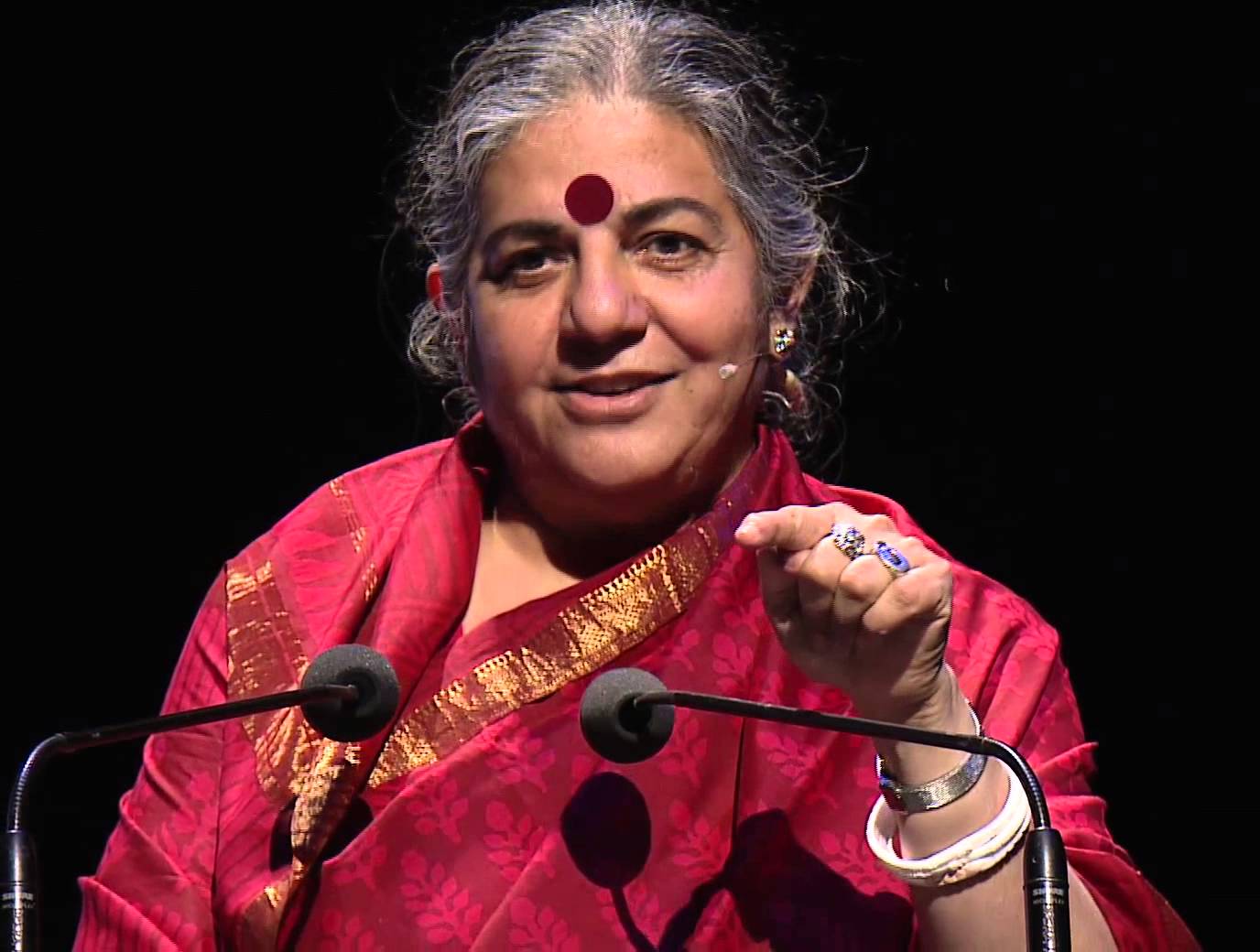Two Indigenous Solar Engineers Changed Their Village in Chile
Liliana and Luisa Terán, two indigenous women from northern Chile who travelled to India for training in installing solar panels, have not only changed their own future but that of Caspana, their remote village nestled in a stunning valley in the Atacama desert.
“It was hard for people to accept what we learned in India,” Liliana Terán told IPS. “At first they rejected it, because we’re women. But they gradually got excited about, and now they respect us.”
Her cousin, Luisa, said that before they travelled to Asia, there were more than 200 people interested in solar energy in the village. But when they found out that it was Liliana and Luisa who would install and maintain the solar panels and batteries, the list of people plunged to 30.
“In this village there is a council of elders that makes the decisions. It’s a group which I will never belong to,” said Luisa, with a sigh that reflected that her decision to never join them guarantees her freedom.
Luisa, 43, practices sports and is a single mother of an adopted daughter. She has a small farm and is a craftswoman, making replicas of rock paintings. After graduating from secondary school in Calama, the capital of the municipality, 85 km from her village, she took several courses, including a few in pedagogy.
Liliana, 45, is a married mother of four and a grandmother of four. She works on her family farm and cleans the village shelter. She also completed secondary school and has taken courses on tourism because she believes it is an activity complementary to agriculture that will help stanch the exodus of people from the village.
But these soft-spoken indigenous women with skin weathered from the desert sun and a life of sacrifice are in charge of giving Caspana at least part of the energy autonomy that the village needs in order to survive.
Caspana – meaning “children of the hollow” in the Kunza tongue, which disappeared in the late 19th century – is located 3,300 metres above sea level in the El Alto Loa valley. It officially has 400 inhabitants, although only 150 of them are here all week, while the others return on the weekends, Luisa explained.
They belong to the Atacameño people, also known as Atacama, Kunza or Apatama, who today live in northern Chile and northwest Argentina.
“Every year, around 10 families leave Caspana, mainly so their children can study or so that young people can get jobs,” she said.
Up to 2013, the village only had one electric generator that gave each household two and a half hours of power in the evening. When the generator broke down, a frequent occurrence, the village went dark.
Today the generator is only a back-up system for the 127 houses that have an autonomous supply of three hours a day of electricity, thanks to the solar panels installed by the two cousins.
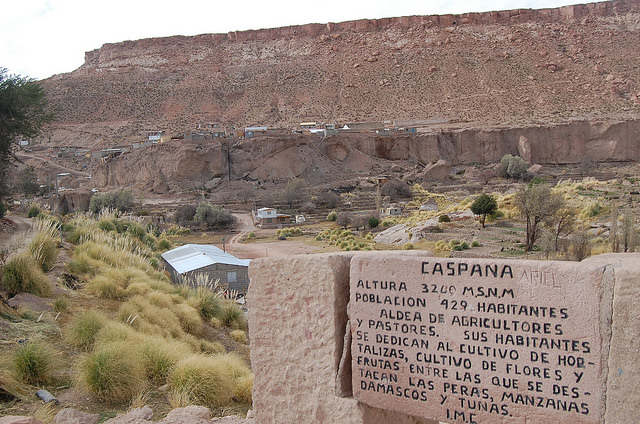
Each home has a 12 volt solar panel, a 12 volt battery, a four amp LED lamp, and an eight amp control box.
The equipment was donated in March 2013 by the Italian company Enel Green Power. It was also responsible, along with the National Women’s Service (SERNAM) and the Energy Ministry’s regional office, for the training received by the two women at the Barefoot College in India.
On its website, the Barefoot College describes itself as “a non-governmental organisation that has been providing basic services and solutions to problems in rural communities for more than 40 years, with the objective of making them self-sufficient and sustainable.”
So far, 700 women from 49 countries of Asia, Africa and Latin America – as well as thousands of women from India – have taken the course to become “Barefoot solar engineers”.
They are responsible for the installation, repair and maintenance of solar panels in their villages for a minimum of five years. Another task they assume is to open a rural electronics workshop, where they keep the spare parts they need and make repairs, and which operates as a mini power plant with a potential of 320 watts per hour.
In March 2012 the two cousins travelled to the village of Tilonia in the northwest Indian state of Rajasthan, where the Barefoot College is located.
They did not go alone. Travelling with them were Elena Achú and Elvira Urrelo, who belong to the Quechua indigenous community, and Nicolasa Yufla, an Aymara Indian. They all live in other villages of the Atacama desert, in the northern Chilean region of Antofagasta.
“We saw an ad that said they were looking for women between the ages of 35 and 40 to receive training in India. I was really interested, but when they told me it was for six months, I hesitated. That was a long time to be away from my family!” Luisa said.
Encouraged by her sister, who took care of her daughter, she decided to undertake the journey, but without telling anyone what she was going to do.
The conditions they found in Tilonia were not what they had been led to expect, they said. They slept on thin mattresses on hard wooden beds, the bedrooms were full of bugs, they couldn’t heat water to wash themselves, and the food was completely different from what they were used to.
“I knew what I was getting into, but it took me three months anyway to adapt, mainly to the food and the intense heat,” she said.
She remembered, laughing, that she had stomach problems much of the time. “It was too much fried food,” she said. “I lost a lot of weight because for the entire six months I basically only ate rice.”
Looking at Liliana, she burst into laughter, saying “She also only ate rice, but she put on weight!”
Liliana said that when she got back to Chile her family welcomed her with an ‘asado’ (barbecue), ’empanadas’ (meat and vegetable patties or pies) and ‘sopaipillas’ (fried pockets of dough).
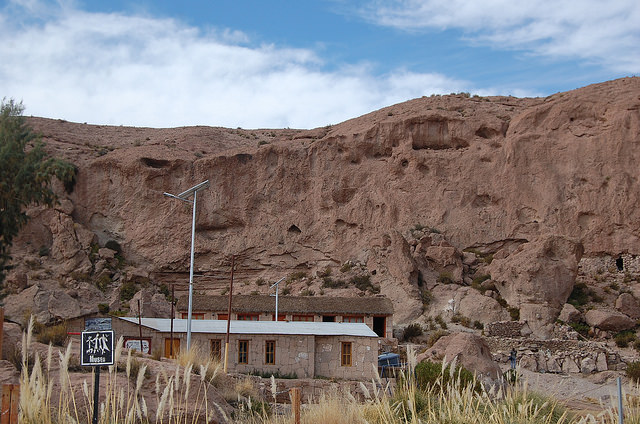
“But I only wanted to sit down and eat ‘cazuela’ (traditional stew made with meat, potatoes and pumpkin) and steak,” she said.
On their return, they both began to implement what they had learned. Charging a small sum of 45 dollars, they installed the solar panel kit in homes in the village, which are made of stone with mud roofs.
The community now pays them some 75 dollars each a month for maintenance, every two months, of the 127 panels that they have installed in the village.
“We take this seriously,” said Luisa. “For example, we asked Enel not to just give us the most basic materials, but to provide us with everything necessary for proper installation.”
“Some of the batteries were bad, more than 10 of them, and we asked them to change them. But they said no, that that was the extent of their involvement in this,” she said. The company made them sign a document stating that their working agreement was completed.
“So now there are over 40 homes waiting for solar power,” she added. “We wanted to increase the capacity of the batteries, so the panels could be used to power a refrigerator, for example. But the most urgent thing now is to install panels in the 40 homes that still need them.”
But, she said, there are people in this village who cannot afford to buy a solar kit, which means they will have to be donations.
Despite the challenges, they say they are happy, that they now know they play an important role in the village. And they say that despite the difficulties, and the extreme poverty they saw in India, they would do it again.
“I’m really satisfied and content, people appreciate us, they appreciate what we do,” said Liliana.
“Many of the elders had to see the first panel installed before they were convinced that this worked, that it can help us and that it was worth it. And today you can see the results: there’s a waiting list,” she added.
Luisa believes that she and her cousin have helped changed the way people see women in Caspana, because the “patriarchs” of the council of elders themselves have admitted that few men would have dared to travel so far to learn something to help the community. “We helped somewhat to boost respect for women,” she said.
And after seeing their work, the local government of Calama, the municipality of which Caspana forms a part, responded to their request for support in installing solar panels to provide public lighting, and now the basic public services, such as the health post, have solar energy.
“When I’m painting, sometimes a neighbour comes to sit with me. And after a while, they ask me about our trip. And I relive it, I tell them all about it. I know this experience will stay with me for the rest of my life,” said Luisa.
This reporting series was conceived in collaboration with Ecosocialist Horizons. Edited by Estrella Gutiérrez/Translated by Stephanie Wildes
If You’re Choking And No One Is There To Help, This Simple Trick Could Save Your Life.
It’s a scary scenario: You’re by yourself when and all of a sudden, food becomes lodged in your throat and you begin to choke. The Heimlich maneuver won’t save you – there is no one there to perform it. The terrible situation could prove deadly – but this could save your life.
Colorado paramedic Jeff Rehman shows a simple technique anyone can use to rescue themselves from choking, and save their own life.
I hope to never have to put this to an actual test, but this trick is really valuable to remember. It’s not even that complicated.
Share this important life-saving technique with others by clicking below. Everyone should know this.
Like us for more! Like us for more!
How To Make Thieves Oil And Why You Should Be Using It Every Day
The recipe varies and dates back to the Middle Ages where Thieves Oil kept a group of merchants safe from the Black Plague. The mixtures of antiseptic, antibacterial, and antimicrobial properties were able to stave off the Plague and keep these merchants safe.
The Thieves Story
In the early 1990s Gary Young studied essential oils and recreated a blend he had been researching. According to Gary there are 17 different version of the “Story of Thieves” and each contains a different amounts of different oils. This intrigued Gary to research essential oils and make the perfect Thieves Oil blend for everyday use.
He researched the properties of the different oils in the multiple ingredients lists he found. His research lead to a proprietary oil blend called Young Living Thieves Essential Oil. His research also lead him to the historical story of the “Thieves” this blend is named after.
Actually spice traders and merchants, the “Thieves” lived in the 15th century and traded the likes of cinnamon and cloves from India across Europe. When the bubonic plague struck, international shipping and trade stopped. The spice traders needed a way to support themselves.
A Dark Time
Dead bodies everywhere, the Thieves decided to loot the plague-ridden bodies to sell the found clothes, boots, jewelry, pots, pans – anything they could get their hands on to trade for food and money. They knew about spices and their medicinal properties and believed they wouldn’t get sick from the dead bodies if they applied their knowledge of spices, vinegars, and oils.
Because their repossession process was lucrative the King found out. He wanted to know their secret – why were they not getting sick? Four of the Thieves were caught and brought before the King. He gave them a choice: Share the secret or be burned at the stake.
A Kingly Proposition
They shared the oil blend secret and the rest is history. The King spread word around town and spread the “medicine” as well. A few recipes have stuck around, so you can make your own Thieves Oil blend, or buy a premixed blend wherever you buy your essential oils.
Thieves Oil Blend #1
40 drops of Clove Essential Oil
35 drops of Lemon Essential Oil
20 drops of Cinnamon Essential Oil
15 drops of Eucalyptus Essential Oil
10 drops of Rosemary Essential Oil
Thieves Oil Blend #2
200 drops of Clove Oil
175 drops of Lemon Oil
100 drops of Cinnamon Bark
75 drops of Eucalyptus Oil
50 drops of Rosemary Oil
Thieves Oil Blend #3
1 tbs. Clove Essential Oil
1 tbs. Lemon Essential Oil
2 ½ tsp. Cinnamon Bark Essential Oil
2 tsp. Eucalyptus Essential Oil
2 tsp. Rosemary Essential Oil
Thieves Oil Blend #4
2 tsp Clove Oil
1 1/2 tsp Lemon Oil
1 tsp Cinnamon Bark Oil
3/4 tsp Eucalyptus Oil
1/2 tsp Rosemary Oil
*Note: One 15 ml bottle of essential oil contains approximately 255 drops. One 5 ml bottle contains approximately 85 drops.
Store these blends in a dark bottle, in a cool place out of the sun. You should use Thieves Oil every day as it can be used for so many different reasons – not to mention it has a nice cinnamon scent. You can diffuse the oil, use it topically, clean household items with it, or ingest it to aid digestion and support your immune system.
Diffusing Thieves Oil
This purifies the air in your home, eliminates odors, acts aromatically to support your lungs and sinuses. Diffuse 15-20 drops of Thieves Oil for 15 minutes three or four time a day in an essential oil diffuser. As you breathe the oil you will strengthen your lungs, sinuses, and entire respiratory system.
Thieves Oil All-Purpose Spray
Make an easy all-purpose spray out of Thieves Oil and water in a spray bottle to clean and disinfect just about everything. Take odor out of pet beds*, clean microbial bacteria off surfaces, and keep baby’s room spic and span with Thieves Oil.
*Note: Cat’s cannot process essential oils – if you’re using this blend to clean a litter box that’s fine, but do not spray on a cat’s bed or use as an aromatic without a diffuser if you’re a cat person.
Add 1 drop of Thieves Oil for every ½ ounce of water used. This is a strong solution that can be lessened to 1 drop per 1 oz if you find it overpowering. You’ll need to shake the bottle vigorously
Topical Thieves Oil
1 drop of Thieves Oil to 4 drops carrier oil. (Grapeseed, Jojoba, Coconut, Avocado – any healthy oil will act as a carrier)
This lets you use Thieves Oil topically. Some folks can use Thieves Oil without a carrier, but some peoples’ skin will get irritated. You can massage this blend on your feet, lower back, neck, and behind your ears. Rubbing this oil blend on your feet daily promotes a healthy immune system.
Household Uses
Because of its antibacterial properties, Thieves Oil is a great all-around cleaner. Add to laundry loads, dishwasher loads, and floor and countertops to remove any stubborn, sticky buildup or even just to give a great, deep clean.
You can freshen up your kids’ stuffed animals or your dog’s bed, clean your cell phone and other devices, even keep plants bug-free and happy. Adding Thieves Oil to a cotton ball placed in the home, car, or office air vents eliminates nasty odors. Thieves Oil even helps to dispel bed bugs!
Massage Therapy
Dilute 15 drops of Thieves Oil with 15 drops of carrier oil and massage over lungs, chest, and back to improve your respiratory system. Massaged into the back, thighs, and neck helps relieve minor aches and pains that come with your daily routine. You can also use Thieves Oil to relieve insect bites.
Ingesting Thieves Oil
Add 1 drop of Thieves oil to a bottle of water and drink all day long. This will help clean your digestive tract and support a healthy immune system. Add Thieves Oil to a cup of warm water and drink as a tea. Wait 15 minutes before eating, and benefit from the system-cleansing oil.
Add 2-3 drops to 2 Tbsp of water and gargle to relieve a sore or dry throat. You can even add 1 drop of Thieve Oil to 1 oz of water and, using a spray bottle, spray onto the back of your throat.
Thieves Oil Miscellaneous
Dilute 1 drop of Thieves Oil into 4 drops of carrier oil and apply to the affected area. You can apply the oil directly, or using a gauze or bandage.
To relieve a headache, put a drop of Thieves Oil on your thumb and place against the roof of your mouth. Be sure not to lick your lips as this may burn.
A few drops of Thieves Oil in a bowl of steaming water and lean over the bowl covering your head with a towel. Inhale the vapors for sinus and lung support.
Using Thieves Oil topically promotes healthy skin, and can help fight acne and other skin issues. Thieves Oil can also be used in the bathroom as toothpaste or mouthwash. Use 1 drop per ounce for mouthwash, and 2 drops to 4 Tbsp of baking soda and shake well.
What can’t Thieves Oil do?
SOURCE:
http://www.natural-aromatherapy-benefits.com/thievesoilrecipe.html
Most of you probably know what Thieves Oil is, but if not have I got a story for you! The name and recipe for Thieves Oil have an interesting backstory and explains why this blend of oils is so good for you.
Showerhead Utilizing Aerospace Technology Uses 70% Less Water
The average person in the U.S. uses between 80 and 100 gallons of water per day, with the largest uses of household water occurring in the toilet and the shower. Even though showers are one of the highest wasters of water, however, they are probably one of the personal experiences people would be willing to make the least compromises with. Nebia is a company that promises to not only improve your showering experience, but also help you use 70 percent less water.
After raising more than $2.5 million on Kickstarter, 17 days before the end of the campaign, the team is ready to start manufacturing, with the first showerheads expected to ship in May, 2016.
The six-person team behind Nebia, which includes several thermal fluid experts, has spent the last five years doing research, solving equations, and building prototypes in order to arrive at a new type of nozzle that, according to them, brings the first innovation in the industry in over 50 years. Meanwhile, the company has attracted investments from Tim Cook of Apple and Eric Schmidt of Alphabet.

The result is impressive. On average, Americans take about eight minutes to shower, which results in using 20 gallons of water. With Nebia, for the same amount of time, one will use up only six gallons, or 70 percent less water. With an initial price of $299, for the average U.S. home, Nebia pays for itself in less than two years.

CEO and co-founder Philip Winter told TechCrunch that “If everyone in California were to switch over to this showerhead, we think we could reduce the state water’s use by 1.5 percent.” In the future, the company also wants to make the technology cheaper and available to developing countries where water is scarce.
“The last half century of nozzle technology has completely changed what we can do with droplet size and distribution, however this technology has only been applied to very specialized fields, like rocket engines and medical devices. We used these same tools and technology to develop Nebia. What we do is atomize streams of water into millions of tiny droplets. By doing this we can achieve 10 times the surface area of water compared to a regular shower and use a fraction of the volume,” says co-founder and CTO Gabriel Parisi-Amon.
According to the creators, Nebia is easy to install – users simply unscrew their existing shower and screw on Nebia with a wrench, plumbers tape, and an included adhesive, without the need to break tiles or call the plumber. The showerhead can slide up and down, pivot at an angle, and includes a portable wand.

India Built The World’s First Solar-Powered Airport
The southern Indian city of Kochi is now the proud home of the world’s first solar-powered airport.
On Aug. 18, the Cochin International Airport Limited (CIAL)-India’s fourth largest international airport in terms of passenger traffic-commissioned a 12 mega watt (MW) solar power project. The airport already had a 1MW solar power plant, which can produce 4,000 units of electricity daily.
With its new solar plant, the airport can now produce 60,000 units of electricity every day, which is more than enough to meet its daily requirement.
“We initiated a pilot project in February 2013 as part of our plan to shift to renewable energy by setting up a 100 kilo watt unit,” VJ Kurian, managing director of CIAL told Quartz in a telephone interview. “When we found that feasible, we set up a 1MW unit in November 2013.”
“We did not want to be identified as just another airport and be confined to it,” Kurian added.
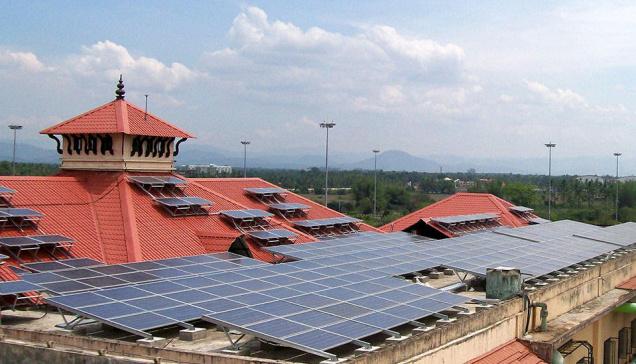
After the airport found the 1MW project financially viable, it invited tenders to set up a 12MW project within the airport complex. “Work on the 12MW project started in February 2015 and was completed in less than six months” Kurian said.
Spread across 45 acres of land-equivalent to 25 football fields-the project was built by German engineering company Bosch for Rs62 crore ($9.5 million). The area for the solar unit was earlier designated for setting up a cargo handling facility.
Since the airport expects to produce more than what it is likely to consume, CIAL is planning to feed some of the power into the state grid.
“Over the next 25 years, this green power project will avoid carbon dioxide emissions from coal fired power plants by more than 3 lakh metric tons, which is equivalent to planting 3 million trees or not driving 750 miles,” CIAL said in a statement.
Meanwhile, close on the heels of Kochi, another Indian airport has also laid out plans to focus on solar. On Aug.18, Kolkata’s Netaji Subhas Chandra Bose International Airport, said that it plans to set up a 15 MW solar power plant on 60 acres of land.
India is currently in the midst of ramping up its solar power generation. The Narendra Modi government has plans to increase the country’s solar power capacity from the existing 4GW (gigawatt) to 100GW (gigawatt)by 2022.
To fund such an ambitious expansion, the government expects an investment of $100 billion in the sector in the next seven years. Some of Asia’s biggest billionaires-including SoftBank’s Masayoshi Son, Gautam Adani and Anil Ambani-have already promised massive investments in the sector.
Alongside, smaller establishments like Kochi’s airport are also joining the party.
Young Bloggers Become Guerrilla Gardening Gangsters
Guerrilla Gardening : The act of impromptu gardening in public spaces for the purpose of beautifying our community. /ɡəˈrilə ˈɡärd(ə)niNG / In this video stars our two phenomenal Web Developers and Coders, Greg and Jordan. The Shady character is Marty, our Networking Specialist and behind the cameras are Germ, Marc and yours truly. This video has been sleeping in …
Amy’s Kitchen To Launch FIRST Organic Drive-Thru Restaurant
The first all-vegetarian drive-thru plans to open later this month in California.
Fans of Amy’s Kitchen – a well-known vegetarian frozen food chain – will be pleased to know that the company is planning on opening the world’s first all-vegetarian drive-thru later this month.
“Everybody said we couldn’t do it,” said Andy Berliner, Amy’s Kitchen co-founder. “But we set up a test kitchen in our warehouse space and did it. We learned how to do it from scratch very quickly.”
Such is definitely a sign of the changing times. Although fast food companies and Pepsi can make fun of health-conscious eaters, the fact-of-the-matter is that making ‘food one’s medicine’ is a priority all people need to take more seriously.
The menu for the drive thru will include gluten and dairy-free meals like tortillas, pizzas (in a rice or wheat crust), and burgers, all vegetarian and all cooked to order with fresh ingredients. Their first
location – as one can only assume this will take off in be in high demand elsewhere – will be located in Rohnert Park, California near the company’s Petaluma headquarters.

“The weather doesn’t always cooperate, so one of the most challenging parts of our business right now is the agricultural end,” disclosed Berliner, who has 50 people in the company working on finding just the right ingredients from farmers 18 months in advance.
“Consumers of all ages, but particularly millennials, are aware that what they eat affects their health, their wellbeing and how they feel,” he added. “We’ve just reached a tipping point in a whole new level of interest in eating better.”
The restaurant’s offerings will definitely be a welcome change from conventional fast-food options. For example, the fries, which come from a farm in California, will be fried in sunflower oil, according to Time.
And even though more work will be required to keep the food fresh, the price is competitive to other establishments. Burgers will cost $2.99 (doubles will be $4.29), cheese pizzas will cost $5.89, burritos $4.69 and salads will range from $3.99 to $7.99.
And if that’s not enough to make you wish every fast food establishment could be replaced with this healthier, more sustainable version, the structure of the drive thru is also more appealing.
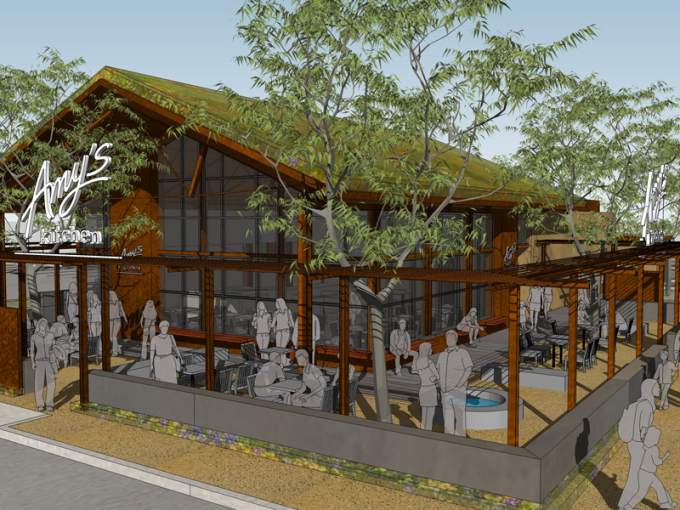
The healthy-oriented restaurant is built where an old barn stood, and all of its wood was shipped back to the Idaho where it will be reused at the company’s plant. Solar panels line its roof and the building will collect and re-use rainwater. Furthermore, scrap metal was collected for construction and the wood furniture was made mostly with unused and discarded lumber off-cuts (the few brand new pieces are Forest Stewardship certified). And finally, all the packaging is printed with non-GMO ink.
Would you eat at an Amy’s restaurant if one was located near you? Share your thoughts in the comment sections below.
.
By Asking One Simple Question, This Teen Saved A Man’s Life
Sometimes it’s the simplest and most humbling moments that matter most.
While it’s easy to get excited about innovative developments in technology, sometimes the simple things in life are what deserve applause and attention.
In the case of a teenager named Jamie Harrington, taking a moment to ask a man if he was okay was enough to prevent him from committing suicide.
As shared on the Humans of Dublin Facebook page, Harrington recalled his encounter one evening with a stranger who was sitting on a bridge:
“I was just on my way to the American sweet shop to buy some Gatorade, when I saw this guy in his 30s sitting on the ledge of the bridge,” Harrington says in his interview. “I stopped and asked him if he was okay … I pleaded with him for a while to come down and sit on the steps, and eventually he did.”
In a brilliant gesture of human kindness and empathy, Harrington talked to the man about his life and why he felt driven to commit suicide. The teen then insisted the man go to St. James Hospital, and called an ambulance. To ensure he could check up on the man later, Jamie also got the man’s number.
That’s not where the positive news ends, however.
“About three months ago, he texted me that his wife is pregnant, they’re having a boy, and they’re naming him after me,” Harrington said. “Can you believe that? They’re going to name their child after me … He said in that moment that I approached him, he was just about to jump, and those few words saved his life. That they’re still ringing in his head every day. ‘Are you okay?'”
This incredible news is hope for anyone in a down place, and inspiration for those seeking to make a difference in the world. Truly, all thoughts and actions matter.
Share this story and uplift someone else’s day. Comment your thoughts below.
Canadian Fruit Pickers Are Living the Dream Summer of BC Bud, Parties, and Being Chill
It was a swelteringly hot day along the sun-scorched banks of the Similkameen River in southern British Columbia. Forest fires burned to the north and south, creating a grungy orange haze over the entire valley. I sat on a log, stoned off my face, plucking a banjo and watching a pack of stray-looking dogs frolic in the water below. It was here at the ramshackle campsite of Dusty and Dusty (two BFFs, both named Dusty) that I’d posted up for the afternoon to drink warm beer and mingle with a community of transient fruit pickers in Keremeos, BC.

Patrick. All photos by the author
My dad escaped to Keremeos 15 years ago to become an amateur farmer and pursue his dream of living a neighbourless life. For as long as I can remember, my visits to the Ol’ Man’s place have consisted of crucial daily trips to the liquor store and participating in the weekly meat raffle at the Veteran’s Hall. On this particular trip however, during the first week of July, I thought I should break this thrilling routine and actually do something.

Elaine and Daphne.
Most commonly remembered as “that place we stopped for gas,” Keremeos is renowned for its lush orchards, sprawling vineyards and abundance of fruit stands. Each one painted and decorated more cartoonishly than the next, by what could have been the set designers from Sesame Street. More memorable than its colourful and fruity main drag are “The Pickers”; the dreadlocked, glazed-eyed, thumbs-out seasonal labourers that swarm the town in the summer. Mostly Québécois, these itinerant hippies hitch-hike from far and wide, looking to make some cash and score sweet BC bud.

Derek.
I set out on Tuesday morning, schlepping my camera gear and a case of Cariboo Lager with the goal of making some new friends. By noon it was 33 Celsius as haggard and exhausted pickers were making their return to the riverside campground following their 4-11AM shifts in the orchards. The first couple I met introduced themselves as “Lux” and “Bear”. Both from Montreal, they had been making pilgrimages to Keremeos for years, picking fruit and selling art out of their van. Lux (who I kept calling “Jet” by mistake) had just gotten a new tattoo on her back-an intricate pink tree that weaved it’s way through several rings and orbs. She explained that it was designed to help keep her chakras aligned.

Guillaume.
I continued trekking through the campground amongst a fluorescent scattering of tents and hanging laundry. Soon I arrived at what appeared to be the “downtown”, a big open space with a large concentration of people milling around and enjoying chill activities. To my left was the “Italian District”, a cluster of shaved-headed pickers, some strumming guitars, others carving sticks. The local hash dealer, a teenager of ’70s Ozzy Osbourne resemblance, zipped by on a rusty children’s mountain bike making deliveries and taking orders. Beneath a tarp to my right, a stick n’ poke tattoo marathon was taking place. I spent the rest of the afternoon taking portraits while getting sunburned and reasonably faded. And despite my clean clothes and recent haircut, I tried to blend in.

Jaryd and Kiki.
The following day was spent cruising the scenic back roads of the valley and offering a complimentary taxi service to anyone in need. To and from their respective camps or the town hotspots (the laundromat, the beer store, the free WIFI-having nook in the alley behind the library), I shuttled truckloads of pickers of a kaleidoscopic variety. From the cherubic 17-year old sporting a Pokemon tank top and bedazzled neon skirt, to the Wiser’s Deluxe-stinking gutter punk whose home was under a highway overpass, the characters were fascinating and endless. The enormity of the scene and collective spirit of these sorta-ambitious fruit hustlers made me realize that the significance of Keremeos was far greater than I’d originally thought. It dawned on me that this must be the Woodstock or the Coachella of fruit picking, and right now cherry season was the headlining act.

Dusty 1.
That evening I drove out to River Valley Farm, a small organic orchard in the hills east of town. I’d planned to reunite with an eclectic crew of hyper French-Canadian teenagers I’d met earlier that day. At the time, being the people-person that I am, I cleverly wrote all of their names on my hand for future reference: Félix, Gabrielle, Leo, Tristan, Godfrey, Guillaume, Kiki, Félix 2, Charlotte, Patrick, Daphne, Vern.

Dusty 2.
River Valley Farm was a slice of heaven. The pickers had been assigned their own rustic bunkhouses, lined up in a row along the quiet grassy shore of the river. As the sun went down, the sky turned a hazy flamingo hue. The Frenchies enthusiastically took turns in front of the camera, maintaining their cool between fits of arm-flailing, mosquito-killing rage. After dark, I continued to resurrect my French skills following an invitation to hang out and play a drinking game called “Buffalo.” In a few short hours, it would be 4 AM and the pickers would be back to the grind, climbing ladders and filling tubs. While some retired to bed, most of us stayed up taking shots, skinny-dipping, and making up freestyle raps.
See more of Chris’ work on his website.

Lux.

Charlotte.

Vern.
 Leo.
Leo.
7 Ways Homes Kept Cool Before The Age Of Air Conditioning
The modern air conditioner was invented only in the 1920s, and it didn’t become a common home feature until the latter half of the 20 th century.
But, while some of us might wonder how our grandparents survived hot and steamy summers, the fact is those older homes had a few tricks up their sleeves. They were designed and built with features to help them stay cool without AC.
Mary Wheeler Schap is a registered architect who designs and restores historic buildings to their former glory in Cincinnati, Ohio. She offered this expert insight into the features that made older homes livable in the heat.
In northern states, it was common to create a “stack effect” by opening windows in the basement and top floor. This generated a cool breeze through the house. Further south, before AC many homes were built on blocks, allowing breezes to flow underneath and help keep them cool all summer long.

Ceilings as high as 10, 12 and even 14 feet were common in older homes. As heat rose to the ceiling, lower areas stayed cool and comfortable. Ceiling fans-powered by electricity or elaborate rope systems-also facilitated air movement.

A transom-a small window over a door-allowed warmer air at the ceiling to circulate up to higher floors, providing more air movement throughout the house. Transoms over exterior doors often had hinges and special hardware. This allowed easy access to open and close, helping create airflow while still providing security.

Many older and historic homes had large, double-hung windows. Opening the top sash would allow hot air near the ceiling to escape. Opening the bottom sash, especially at night, allowed cool air to flow inside. Rooms had many windows, some as large as doors. Thick, long draperies were often used in these large windows to keep out the heat. People would “draw the drapes” to help keep a room cool without sacrificing light.
I’m a historic preservationist and have been to many workshops and classes about window restoration. Most people have no idea how original windows were meant to function. When you open both sashes to the middle, heat escapes from the top and cool comes in from the bottom. If you do that in your entire house, you have an ac that works almost as well as modern ACs. The thing is, people have painted their sashes shut, especially upper sashes. Most people don’t even know that upper sashes are supposed to open. People installed triple track aluminum windows which only have one screen, at the bottom, which makes two sashes useless and why most upper sashes ended up painted/caulked shut.
If you restore your original double hung windows, and install a wood storm window with screens on upper and lower, you will have a window that is just as energy efficient as “replacement” windows and will outlast and outperform any new window. Unfortunately, people don’t believe this, they just believe what the window salesman tell them. You’ll NEVER save money with replacement windows. There is no return on investment EVER because it would take a minimum of 40yrs to see a return and no replacement window would last that long before needing replaced again. The data is out there. There have been thermal imaging studies done on the efficiency of original windows and on opening both sashes for air condition. Very efficient. With a minimal amount of work, any home owner can restore original windows, for cheaper than the cost of replacement, and have a much higher quality window that will last another 100yrs.”
read more here


